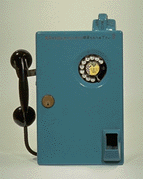
|
||

|
Due to a shortage of coins after World War II, some public telephones had to accept currency to pay for calls, leading to the use of common-battery public telephones with coin boxes modified to accept paper currency. These telephones had no connecting circuits between the money box and phone line, so that it was possible to make calls free of charge. In 1952, however, 10-yen coins begin to circulate and the following year sees the introduction of the coin-operated No. 4 automatic public box telephone. This is the first of the public "blue phones," and is followed in Showa 43 (1968) by the large-size "blue phone" and hen in Showa 48 (1973) by the new-model "blue phone." | |

|
||